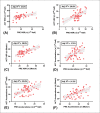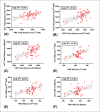Do players with superior physiological attributes outwork their less-conditioned counterparts? A study in Gaelic football
- PMID: 38188097
- PMCID: PMC10765432
- DOI: 10.5114/biolsport.2024.129479
Do players with superior physiological attributes outwork their less-conditioned counterparts? A study in Gaelic football
Abstract
This study investigated the association of physiological attributes with in-game workload measures during competitive Gaelic football match-play. Fifty-two male developmental level Gaelic football players (mean ± SD; age: 22.9 ± 3.8 years) underwent measurements of anthropometric characteristics, running speed, muscular strength and power, blood lactate (BLa), running economy and aerobic capacity during two separate testing visits. Global Positioning System units (18-Hz) were used to record players in-game workloads during a competitive match 1-week following the baseline physiological assessments. Results indicated that players body fat percentage, drop jump height (DJ) and running velocity at 4 mmol · L-1 BLa were significantly associated with the number of high-speed runs completed (Adjusted R2 26.8% to 39.5%; p < 0.05) while 20 m running speed, running velocity at 2 mmol · L-1 BLa and DJ were significantly associated with the number of accelerations completed (Adjusted R2 17.2% to 22.0%; p < 0.05) during match-play. Additionally, aerobic capacity and body fat percentage were significantly associated with total distance (Adjusted R2 14.4% to 22.4%; p < 0.05) while body fat percentage, DJ and 20 m running speed were significantly associated with high-speed distance (Adjusted R2 17.8% to 22.0%; p < 0.05). Players were also divided into higher-standard and lower-standard groups using a median split of these physiological attributes. Players in the higher-standard groups completed significantly more high-speed runs and accelerations and covered significantly larger total and high-speed distances (+10.4% to +36.8%; ES = 0.67 to 0.88; p < 0.05) when compared to the lower-standard groups. This study demonstrates that superior levels of physical conditioning are associated with larger in-game workloads during Gaelic football match-play.
Keywords: Aerobic capacity; External loads; GPS; Neuromuscular; Physical fitness; Team Sport.
Copyright © Biology of Sport 2024.
Conflict of interest statement
Authors declared no conflict of interest.
Figures





Similar articles
-
Positional Match Running Performance in Elite Gaelic Football.J Strength Cond Res. 2016 Aug;30(8):2292-8. doi: 10.1519/JSC.0000000000001309. J Strength Cond Res. 2016. PMID: 26694505
-
Investigation in to the Positional Running Demands of Elite Gaelic Football Players: How Competition Data Can Inform Training Practice.J Strength Cond Res. 2020 Jul;34(7):2040-2047. doi: 10.1519/JSC.0000000000002492. J Strength Cond Res. 2020. PMID: 29533361
-
Does Physical Conditioning Influence Performance Attenuation and Recovery in Gaelic Football?Int J Sports Physiol Perform. 2022 Mar 3;17(6):862-870. doi: 10.1123/ijspp.2021-0342. Print 2022 Jun 1. Int J Sports Physiol Perform. 2022. PMID: 35240577
-
Match analysis and the physiological demands of Australian football.Sports Med. 2010 Apr 1;40(4):347-60. doi: 10.2165/11531400-000000000-00000. Sports Med. 2010. PMID: 20364877 Review.
-
Match Running Performance in Young Soccer Players: A Systematic Review.Sports Med. 2019 Feb;49(2):289-318. doi: 10.1007/s40279-018-01048-8. Sports Med. 2019. PMID: 30671900
Cited by
-
Relating Anthropometric Profile to Countermovement Jump Performance and External Match Load in Mexican National Team Soccer Players: An Exploratory Study.Sports (Basel). 2025 Jul 18;13(7):236. doi: 10.3390/sports13070236. Sports (Basel). 2025. PMID: 40711121 Free PMC article.
-
Estimating oxygen uptake in simulated team sports using machine learning models and wearable sensor data: A pilot study.PLoS One. 2025 Apr 21;20(4):e0319760. doi: 10.1371/journal.pone.0319760. eCollection 2025. PLoS One. 2025. PMID: 40258017 Free PMC article.
-
Predictive analysis of ratings of perceived exertion in elite Gaelic football.Biol Sport. 2024 Oct;41(4):61-68. doi: 10.5114/biolsport.2024.134753. Epub 2024 Mar 6. Biol Sport. 2024. PMID: 39416493 Free PMC article.
References
-
- Mangan S, Collins K, Burns C, O’Neill C. The positional technical and running performance of sub-elite Gaelic football. Sci Med Footb. 2020; 4(3):182–91. doi: 10.1080/24733938.2019.1679872. - DOI
-
- Keane S, Reilly T, Borrie A. A comparison of fitness characteristics of elite and non-elite Gaelic football players. Sci and Footb III. 1997:3–6. doi: 10.3390/app11030954. - DOI
LinkOut - more resources
Full Text Sources
